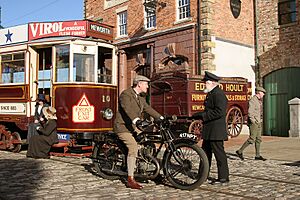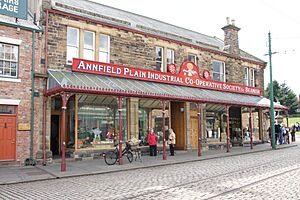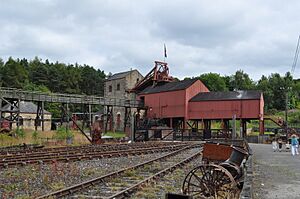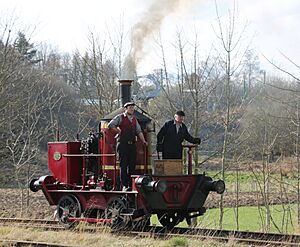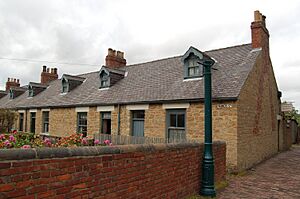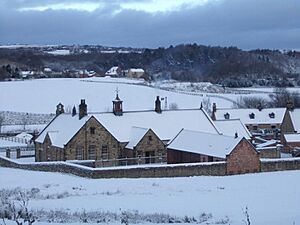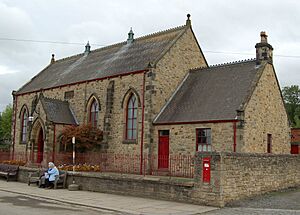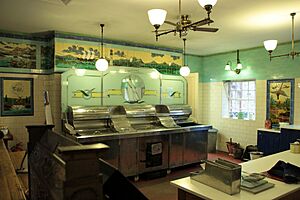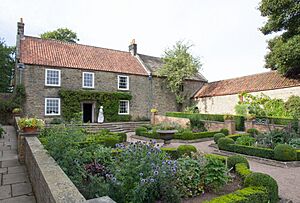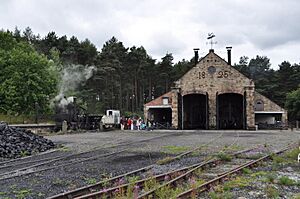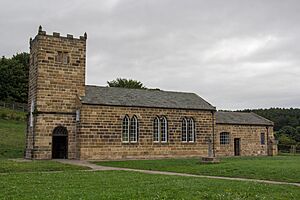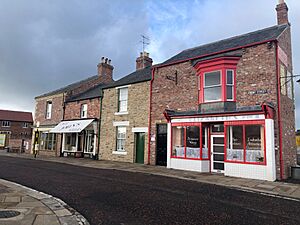Beamish Museum facts for kids
 |
|
| Lua error in Module:Location_map at line 420: attempt to index field 'wikibase' (a nil value). | |
| Established | 1972 |
|---|---|
| Location | Beamish, Stanley, County Durham, England |
| Type | Open-air living museum |
| Collection size | 304,000+ objects |
| Visitors | 801,756 in 2023 |
Beamish Museum is a special kind of museum in County Durham, England. It's called an open-air museum because many of its exhibits are outdoors. It was the first museum in England to show what everyday life was like in a whole region.
Beamish is known for being a "living museum." This means you can often touch things and see people dressed in old clothes acting out daily life. The museum's main goal is to show how people lived and worked in North East England during the early 1900s, when industries like coal mining were very important. It also shows parts of the countryside from the 1820s.
The museum covers a huge area of about 350 acres. It has real buildings that were moved from other places, copies of old buildings, and a large collection of old items. You can also see working vehicles, old equipment, farm animals, and people dressed in costumes who help bring history to life.
Since it opened in 1972, Beamish Museum has won many awards. It's a great place to learn about history and it even helps protect rare types of farm animals from Northern England.
Contents
- History of Beamish Museum
- Exploring the Museum Site
- Who Runs Beamish Museum?
- Museum Areas to Explore
- The 1913 Town
- Riding the Tramway
- The Bakery
- The Motor Garage
- The Department Store
- Ravensworth Terrace Houses
- The Pub
- Town Stables
- Printer and Newspaper Office
- The Sweet Shop
- The Bank
- Masonic Hall
- Chemist and Photographer
- Redman Park
- Other Town Features
- The Railway Station
- Fairground Fun
- The Colliery
- The Pit Village
- The Georgian North (1825)
- Home Farm (1940s)
- The 1950s Town
- The 1913 Town
- Museum Storage Areas
- Transport Collection
- Farm Animals
- Regional Heritage and Collections
- Filming Location
- Images for kids
- See also
History of Beamish Museum
How the Museum Started
The idea for Beamish Museum began in 1958. A museum director named Frank Atkinson noticed that old industries and ways of life in North East England were disappearing. He was inspired by similar museums in Scandinavia.
Atkinson suggested that a large collection of everyday historical items should be gathered quickly. He wanted to create an open-air museum that would "make the history of the region live." He hoped it would show the lives of ordinary people and be a museum for the local community.
People started donating all sorts of things, from small objects to huge locomotives and even entire shops! Atkinson first stored these items at the Bowes Museum, then in an old army tank depot. Both places quickly filled up.
In 1966, a group was formed to set up the museum. They chose Beamish Hall as the perfect spot.
Opening and Growing
In August 1970, Frank Atkinson became the first full-time director of Beamish, with a small team. They started moving collections into Beamish Hall. In 1971, a special exhibition called "Museum in the Making" opened.
The museum first welcomed visitors in 1972. The first buildings moved to the site, a railway station and a colliery winding engine, were put up the next year. Trams started running on a short line in 1973.
Over the years, more areas opened. The Town station was officially opened in 1976. The colliery winding engine house was finished that same year, and miners' cottages were moved. The drift mine opened as an exhibit in 1979.
Famous visitors have included Queen Elizabeth The Queen Mother in 1975 and Anne, Princess Royal in 2002.
The Town area, with its Co-op store, officially opened in 1985. The pub and Ravensworth Terrace houses also opened around this time. Home Farm opened in 1983.
In the 1990s, the Pit Village grew with a chapel (1990) and a school (1992). The full tram circle was working by 1993. The sweet shop and motor garage opened in the Town in 1994, followed by the bank in 1999. The first Georgian area, Pockerley Old Hall, opened in 1995, and the Pockerley Waggonway in 2001.
New buildings for museum operations and storage were added in the early 2000s. The Masonic lodge opened in 2006, and the Lamp Cabin in the Colliery in 2009. More shops and buildings were added to the Town and Pit Village in the 2010s, like the fish and chip shop (2011) and the bakery (2013). St Helen's Church in the Georgian area opened in 2015.
Remaking Beamish Project
A big project called 'Remaking Beamish' started in 2016. It received a lot of money to build new exhibits.
By 2022, new areas included a quilter's cottage, a welfare hall, a 1950s street, a park, a bus depot, and a 1950s farm. Future plans include homes from the 1950s, a cinema, and more social housing.
Exploring the Museum Site
The museum is built in a valley with woods and a river. Visitors enter through a special archway.
You can walk around the museum on marked paths. It takes about 20 minutes to walk from the entrance to the Town. You can also ride the museum's trams and buses for free to get around. There are also train rides on the Town railway and Pockerley Waggonway, but these are just for fun, not for transport around the whole site.
Who Runs Beamish Museum?
Beamish was the first museum in England to be funded by several local councils working together. Today, it's run as a charity, but it still gets support from local councils. The museum earns most of its money from visitor tickets.
Museum Areas to Explore
The 1913 Town
The Town area, which opened in 1985, shows what a typical town looked like in 1913. The buildings are mostly from the Victorian era.
Riding the Tramway
The Beamish Tramway is about 1.5 miles long. It goes around the museum site and is a fun way for visitors to travel.
Trams started running here in 1973, and the full circle was completed by 1993. These electric trams show how towns and cities in the North East changed from horse-drawn transport to electric power in the late 1800s.
The Bakery
The bakery, called Joseph Herron, Baker & Confectioner, opened in 2013. It has working ovens that bake food for visitors to buy. It shows how new businesses grew to serve the middle class. The building was moved from Anfield Plain and has stained glass from a baker's shop in South Shields.
The Motor Garage
The Beamish Motor & Cycle Works opened in 1994. In 1913, not many people owned cars, so garages were special places. This garage has a showroom and a repair area. Many of the museum's old cars, motorcycles, and bicycles are kept here.
The Department Store
This large store, called the Annfield Plain Industrial Co-operative Society Ltd, opened in 1984. It was moved from Annfield Plain. It sells products from the Co-operative Wholesale Society. The ground floor has grocery, fabric, and hardware sections. Upstairs are tea rooms. The store has a special cash carrier system that sends money and receipts around the shop.
Ravensworth Terrace Houses
Ravensworth Terrace is a row of houses that show how professionals lived. These houses were moved from Bensham Bank and rebuilt at the museum between 1980 and 1985. They are two stories tall.
- No. 2 is the home of Miss Florence Smith, a music teacher. It has older furniture, like her parents might have had.
- No. 3 & 4 is the office and home of dentist J. Jones. It shows a check-up room, a surgery for pulling teeth, and a room for making false teeth. His home is more modern, with an Edwardian style.
- No. 5 is a solicitor's office, like a lawyer's office. It shows how business was done back then.
The Pub
The pub, called The Sun Inn, opened in 1985. It was originally in Bishop Auckland. It was a popular spot for miners. The pub is still open and serves drinks. It has a front and back bar.
Town Stables
The town stables show how important horses were for transport. It's set up like a typical jobmaster's yard, with stables and a tack room. There's also a blacksmith's shop. Many of the museum's horses and horse-drawn vehicles are kept here.
Printer and Newspaper Office
This building is a copy of a real office from the mid-1980s. It's presented as the Beamish Branch Office for two newspapers. Downstairs, you could buy newspapers and place ads. On the left is a stationery shop. Upstairs is a workshop where they printed leaflets, posters, and office papers. You can see old printing presses working here.
The Sweet Shop
The sweet shop, Jubilee Confectioners, opened in 1994. It looks like a family-run shop with living quarters upstairs. In the front, traditional sweets and chocolate are sold to visitors. In the back, you can watch how sweets were made.
The Bank
The Barclays Bank branch opened in 1999. It shows how local banks were becoming part of bigger national banks. It's a three-story building with teller windows and a bank manager's office on the ground floor. There are also two vaults in the basement.
Masonic Hall
The Masonic Hall opened in 2006. It has the front of an old masonic hall from Sunderland. It shows the main meeting hall, a room for robes, and a museum room with masonic items.
Chemist and Photographer
This two-story building, W Smith's Chemist and JR & D Edis Photographers, opened in 2016. It shows how popular photography became. Shops often combined photography with chemists because they had the right supplies. The chemist has a dispensary and old equipment. The photographer's studio lets visitors dress up in old costumes for a photo. The chemist also sells old-fashioned fizzy drinks in special bottles.
Redman Park
Redman Park is a small grassy area with flowers, across from Ravensworth Terrace. It has a Victorian bandstand from Saltwell Park. It shows how people wanted places to relax away from busy industrial areas.
Other Town Features
The Town also has old-fashioned drinking fountains and other street items. There's a combined tram and bus waiting room with public toilets between the bank and the sweet shop.
The Railway Station
East of the Town is the Railway Station. It looks like a typical small station for passengers and goods, run by the North Eastern Railway. A short train line runs west around the north side of the Town.
Rowley Station Building
Rowley Station, which opened in 1976, was moved to the museum from the village of Rowley. The original station opened in 1845. The building was added in 1873. Passenger service stopped in 1939. The museum took the building apart in 1972 and rebuilt it here.
The station is set up as an Edwardian station, lit by oil lamps. It has a waiting area and a ticket office. A large map of the railway is in the waiting room.
Signal Box
The signal box is from 1896 and was moved from Carrhouse. It has old signaling equipment and levers that controlled the railway tracks. Visitors can look inside.
Goods Shed
The goods shed is from Alnwick. It shows how cargo was moved from trains to road vehicles. It has a covered platform where goods could be loaded and unloaded.
Coal Yard
The coal yard shows how coal was moved from trains to local sellers. It has a coal drop that unloads coal from railway wagons into road wagons below. There's also a weighbridge and a coal merchant's office.
Bridges and Level Crossing
The station has two footbridges. One is from Howden-le-Wear, and the other is from Dunston. There's also a gated level crossing where a road crosses the tracks.
Waggon and Iron Works
The large building that looks like Beamish Waggon and Iron Works is actually the Regional Museums Store (see below). It has two covered tracks where the railway's locomotives and trains are stored and fixed.
Fairground Fun
Next to the station is a fairground with a set of steam-powered Gallopers from 1893.
The Colliery
The colliery, called Beamish Colliery, shows the coal mining industry that was so important in the North East. In 1913, over 165,000 men and boys worked in 304 mines in this area. Mining was dangerous, but miners were paid well. Children could start working at age 12, but couldn't go underground until they were 14.
Deep Mine Buildings
The main buildings at the colliery are the brick Winding Engine House and the red wooden Heapstead. These were moved to the museum from other collieries. The winding engine and its house are very important historical buildings.
The winding engine pulled miners, equipment, and coal up and down the mine shaft. The Heapstead is where the coal was brought to the surface, weighed, and sorted before being loaded onto railway wagons.
The winding engine is the only one of its kind still working. It was built in 1855. Inside the winding engine house, there's also a smaller jack engine used for lifting heavy equipment.
Outside, there's a sinking engine from Silksworth Colliery, built in 1868. Sinking engines were used to dig new mine shafts.
Drift Mine Tours
The Mahogany Drift Mine is an original mine at Beamish, opened in 1855. It opened as a museum exhibit in 1979. You can see the winding engine and a short track. Visitors can take a guided tour inside the mine shaft.
Lamp Cabin
The Lamp Cabin opened in 2009. It's a copy of a building where miners' safety lamps were kept. It shows how lamps were stored and how a system of tokens tracked miners underground.
Colliery Railways
The colliery has both standard gauge and narrow-gauge railways. The standard gauge railway shows how coal was transported. It has two engine sheds. The larger one, Beamish Engine Works, is a copy of an old engine shed and stores locomotives.
The narrow-gauge railway is used for internal purposes. There are many old steam locomotives and chaldron wagons, which were traditional coal wagons. The locomotive Coffee Pot No 1 often runs in the summer.
The Pit Village
The pit village next to the colliery shows life in the mining communities. Many of these villages grew only because of the coal industry.
Miners' Cottages
The row of six miners' cottages in Francis Street shows the homes provided by mine owners. They were moved from Hetton-le-Hole and built in the 1860s. They have a kitchen at the back and a parlor at the front. Children often slept in the attic. The gardens were used for growing food.
- No. 2 is a Methodist family's home with nice furniture.
- No. 3 is an Irish Catholic immigrant family's home with valuable items.
- No. 3 (another one) is a poorer home, lived in by a miner's widow.
The cottages show examples of folk art. In the alley behind the cottages, there's a shared bread oven, which was common before homes had their own ovens.
Village School
The school opened in 1992. It's a typical school from that time, where attendance was required, but children left at age 12. Lessons involved learning by repeating things. The building was moved from East Stanley. It has separate entrances for boys and girls and three classrooms.
The Chapel
Pit Hill Chapel opened in 1990. It represents the Wesleyan Methodist church, which was popular in the North East. Chapels were used for both religious services and community events. It has a stained glass window and old communion sets. It also has a screen for magic lantern shows.
Fish and Chip Shop
Davey's Fried Fish & Chip Potato Restaurant opened in 2011. It shows a typical fish and chip shop from that time. It has coal-fired ranges that use beef dripping. The shop is named after the last coal-fired chip shop in Tyneside. The serving counter and one of the fryers came from the original Davy shop.
Band Hall
The Hetton Silver Band Hall opened in 2013. It shows the important role of colliery bands in mining communities. It was built in 1912 by the Hetton Silver Band using prize money from a music competition. It's believed to be the only purpose-built band hall in the region and is still used for performances.
Pit Pony Stables
The Pit Pony Stables were built in 2013/14. They house the museum's pit ponies. These stables are like those used in drift mines, where ponies helped transport coal. Pit ponies were used in the North East until 1994.
Other Village Features
Sinker's Bait Cabin represents temporary homes and canteens for workers who dug new mine shafts. The village fields also have a quoits pitch, a traditional game. A small brick tower called the Cupola stands in one field. These were often placed over old mine shafts.
The Georgian North (1825)
This area shows a late Georgian landscape from 1825. It focuses on changes in farming and transport. It became part of the museum in 1990 and opened as an exhibit in 1995. The land is farmed using old methods and traditional animal breeds.
Pockerley Old Hall
Pockerley Old Hall shows the home of a wealthy tenant farmer. The hall has an Old House and a New House. The Old House has parts dating back to the 1440s. The New House is from the late 1700s. Visitors can explore most rooms. Displays include old cooking methods.
The New House has a main kitchen, a smaller kitchen, a pantry, and a living room. Upstairs are bedrooms for the family and servants. The Old House is set up as if only the upper story was used, with a main room for cooking and sleeping. The lower level, called an undercroft, was once a defensive area but is now a storage room.
The garden in front of the hall has herbs, flowers, and vegetables, designed like gardens from the early 1800s. The farm buildings next to the hall are from around 1800 and include stables and a cart shed.
Pockerley Waggonway
The Pockerley Waggonway opened in 2001. It represents the year 1825, when the Stockton and Darlington Railway opened. Waggonways were common in mining areas and were first powered by horses or gravity before steam engines were invented.
The Great Shed houses the locomotives and trains. Visitors can walk around the trains and take rides. There's also an office for a locomotive designer. At the end of the waggonway is a pretend coal mine, Pockerley Gin Pit, which the waggonway serves. It has a horse-powered machine called a whim gin, used to pull things up mine shafts.
Wooden Waggonway
After the Pockerley Waggonway, the museum also built a horse-worked wooden waggonway, showing an even older type of railway.
St Helen's Church
St Helen's Church looks like a typical country church from North Yorkshire. It was moved from its original site in Eston and opened in November 2015. It's the oldest and most complex building moved to the museum.
The church has parts from around 1100, but the building itself is from three different times: the chancel (east end) from 1450, the nave (main part) updated in 1822, and the bell tower from the late 1600s. It has old box pews from a church in Somerset. Visitors can explore most of the church. A shed for a horse-drawn hearse has also been rebuilt nearby.
Joe the Quilter's Cottage
This cottage opened in 2018. It's a copy of the home of a Georgian quilter named Joseph Hedley. Stones from his original home were found during an archaeological dig. The exhibit tells the story of quilting and how small home businesses grew in the early 1800s. Volunteers often tell the story of Joe's unsolved murder in 1826 and let visitors try quilting.
Other Georgian Features
A pack pony track goes through this area. Pack horses were used to carry heavy goods where there were no waggonways.
Home Farm (1940s)
This area, called Home Farm, shows what farms in the North East were like during World War II. It shows life inside the farmhouse and outside on the land. Much of the farm is original and opened as a museum exhibit in 1983. It was set up as a 1940s farm in 2014.
The farmhouse has been updated with electricity and a modern cooker, but the main kitchen still has a coal-fired range. An office next to the kitchen was used for farm administration and as a local Home Guard office. Outside, there's a small shelter made from an old steam boiler, used by the Home Guard.
The farm has three tractors from the war era. It also uses horse-drawn traps because petrol was rationed during the war. The farming equipment shows the change from horse-drawn to tractor-pulled tools. The farm has traditional breeds of sheep, cattle, pigs, and chickens.
Two cottages on the farm housed farm workers. Orchard Cottage is set up as if a family of evacuees lived there. Garden Cottage is set up as a home for members of the Women's Land Army (Land Girls). Orchard Cottage has an Anderson shelter in its orchard.
The British Kitchen is both an exhibit and a place to eat. It looks like one of the wartime British Restaurants, with old posters and a patriotic menu.
The 1950s Town
As part of the Remaking Beamish project, the museum is building a 1950s town. The Welfare Hall opened in July 2019. It's a copy of a real welfare hall from 1957. Visitors can take part in activities like dancing and crafts. There's also an exhibition about the National Health Service. A park called Coronation Park opened in May 2022.
The museum's first 1950s street opened in February 2022. It includes a fish and chip shop, a cafe, a copy of artist Norman Cornish's home, and a hairdressers. Future plans include a cinema, toy and electrician shops, a bowling green, police houses, and aged miners' cottages.
A 1950s bus depot has also opened on the western side of the museum. This helps store buses, trolleybuses, and trams.
Spain's Field Farm
In March 2022, Spain's Field Farm opened. This farm had stood for centuries in Weardale and was moved to Beamish stone by stone. It shows what a farm was like in the 1950s.
Future 1820s Expansion
More developments are planned around Pockerley Old Hall. There are plans for 1820s industries like a blacksmith's forge and a pottery.
Museum Storage Areas
The museum has two storage areas for donated items. Beamish tries to have most of its items on display or in use. Stored items are usually for future exhibits.
Open Store
The Open Store is in the Regional Resource Centre and visitors can access it. Objects are on shelves, and some are in a special rolling archive that lets you view them without touching.
Regional Museums Store
The building that looks like Beamish Waggon and Iron Works next to Rowley Station is actually the Regional Museums Store. It was finished in 2002 and is shared with Tyne and Wear Museums. It holds large items like a marine diesel engine and boats. It's usually open for special tours, but you can also look through viewing windows.
Transport Collection
The museum has many interesting vehicles for roads, railways, and tramways. Because the museum is so big, these vehicles are also used to transport visitors and staff around the site.
Farm Animals
The museum's two farms help protect traditional and rare farm animal breeds. These include Durham Shorthorn Cattle, Clydesdale and Cleveland Bay working horses, Dales ponies, Teeswater sheep, Saddleback pigs, and poultry.
Regional Heritage and Collections
Other large exhibits at the museum include a tracked steam shovel and a coal drop from Seaham Harbour.
In 2001, a new Regional Resource Centre opened. It holds the museum's main collections of smaller items. These include over 300,000 old photographs, books, and oral history recordings. The collections cover things like quilts, rag rugs, trade union banners, old advertising, local pottery, folk art, and old costumes. Many items can be seen online, and you can watch demonstrations of quilting, rug making, and cooking at the museum.
Filming Location
Beamish Museum has been used as a setting for many films and TV shows. These include dramas produced by Tyne Tees Television, the final episode and movie version of Downton Abbey, and parts of the children's TV series Supergran.
Visitor Numbers
On its opening day, the museum had a two-hour queue! Visitor numbers quickly grew to around 450,000 per year in the first ten years. The millionth visitor arrived in 1978.
Awards and Recognition
| Award | Issuer | Year | Reference |
|---|---|---|---|
| Museum of the Year | 1986 | ||
| European Museum of the Year Award | 1987 | ||
| Living Museum of the Year | 2002 | ||
| Large Visitor Attraction of the Year | North East England Tourism awards | 2014 & 2015 | |
| Large Visitor Attraction of the Year (bronze) | VisitEngland awards | 2016 | |
| Museum of the Year | 2025 |
In 1997, it was recognized as a museum with amazing collections.
What People Think of Beamish
Some people say Beamish focuses too much on nostalgia (looking back fondly at the past). But the museum believes it's important for people to "understand ourselves in time."
The BBC said that Beamish changed how museums work because of its unique way of collecting items. What makes it special is that people in costumes share knowledge with visitors, instead of just using labels. This helps visitors connect with history in a unique way.
Beamish's Impact
Beamish has influenced other living museums like the Black Country Living Museum and Blists Hill Victorian Town. It's also a very important place for education in the local area and helps the local economy.
The museum's policy of collecting all sorts of items has created a strong connection between the museum and the community.
Images for kids
-
Consett Iron Company tank wagon 41
See also
- Amberley Museum & Heritage Centre – Amberley, West Sussex
- Avoncroft Museum of Historic Buildings – Bromsgrove, England
- Black Country Living Museum – Dudley, England
- Blists Hill Victorian Town – Telford, England
- Cregneash – The National Folk Museum at Cregneash, Isle of Man
- Highland Folk Museum – Newtonmore, Scotland
- Milestones Museum – Basingstoke, England
- St Fagans National Museum of History – Museum of Welsh Life, Cardiff, Wales
- Summerlee Museum of Scottish Industrial Life – Coatbridge, Scotland
- Ulster Folk and Transport Museums – Cultra, Northern Ireland


